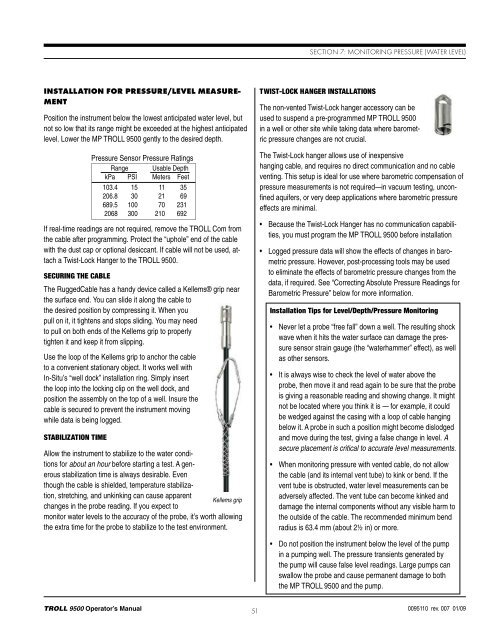TROLL 9500 Operator's Manual - Geotech Environmental Equipment
TROLL 9500 Operator's Manual - Geotech Environmental Equipment
TROLL 9500 Operator's Manual - Geotech Environmental Equipment
Create successful ePaper yourself
Turn your PDF publications into a flip-book with our unique Google optimized e-Paper software.
Section 7: Monitoring Pressure (Water Level)Installation for Pressure/Level MeasurementPosition the instrument below the lowest anticipated water level, butnot so low that its range might be exceeded at the highest anticipatedlevel. Lower the MP <strong>TROLL</strong> <strong>9500</strong> gently to the desired depth.If real-time readings are not required, remove the <strong>TROLL</strong> Com fromthe cable after programming. Protect the “uphole” end of the cablewith the dust cap or optional desiccant. If cable will not be used, attacha Twist-Lock Hanger to the <strong>TROLL</strong> <strong>9500</strong>.Securing the CableThe RuggedCable has a handy device called a Kellems® grip nearthe surface end. You can slide it along the cable tothe desired position by compressing it. When youpull on it, it tightens and stops sliding. You may needto pull on both ends of the Kellems grip to properlytighten it and keep it from slipping.Use the loop of the Kellems grip to anchor the cableto a convenient stationary object. It works well withIn-Situ’s “well dock” installation ring. Simply insertthe loop into the locking clip on the well dock, andposition the assembly on the top of a well. Insure thecable is secured to prevent the instrument movingwhile data is being logged.Stabilization TimePressure Sensor Pressure RatingsRange Usable DepthkPa PSI Meters Feet103.4 15 11 35206.8 30 21 69689.5 100 70 2312068 300 210 692Allow the instrument to stabilize to the water conditionsfor about an hour before starting a test. A generousstabilization time is always desirable. Eventhough the cable is shielded, temperature stabilization,stretching, and unkinking can cause apparentKellems gripchanges in the probe reading. If you expect tomonitor water levels to the accuracy of the probe, it’s worth allowingthe extra time for the probe to stabilize to the test environment.Twist-Lock Hanger InstallationsThe non-vented Twist-Lock hanger accessory can beused to suspend a pre-programmed MP <strong>TROLL</strong> <strong>9500</strong>in a well or other site while taking data where barometricpressure changes are not crucial.The Twist-Lock hanger allows use of inexpensivehanging cable, and requires no direct communication and no cableventing. This setup is ideal for use where barometric compensation ofpressure measurements is not required—in vacuum testing, unconfinedaquifers, or very deep applications where barometric pressureeffects are minimal.• Because the Twist-Lock Hanger has no communication capabilities,you must program the MP <strong>TROLL</strong> <strong>9500</strong> before installation• Logged pressure data will show the effects of changes in barometricpressure. However, post-processing tools may be usedto eliminate the effects of barometric pressure changes from thedata, if required. See “Correcting Absolute Pressure Readings forBarometric Pressure” below for more information.Installation Tips for Level/Depth/Pressure Monitoring• Never let a probe “free fall” down a well. The resulting shockwave when it hits the water surface can damage the pressuresensor strain gauge (the “waterhammer” effect), as wellas other sensors.• It is always wise to check the level of water above theprobe, then move it and read again to be sure that the probeis giving a reasonable reading and showing change. It mightnot be located where you think it is — for example, it couldbe wedged against the casing with a loop of cable hangingbelow it. A probe in such a position might become dislodgedand move during the test, giving a false change in level. Asecure placement is critical to accurate level measurements.• When monitoring pressure with vented cable, do not allowthe cable (and its internal vent tube) to kink or bend. If thevent tube is obstructed, water level measurements can beadversely affected. The vent tube can become kinked anddamage the internal components without any visible harm tothe outside of the cable. The recommended minimum bendradius is 63.4 mm (about 2½ in) or more.• Do not position the instrument below the level of the pumpin a pumping well. The pressure transients generated bythe pump will cause false level readings. Large pumps canswallow the probe and cause permanent damage to boththe MP <strong>TROLL</strong> <strong>9500</strong> and the pump.<strong>TROLL</strong> <strong>9500</strong> Operator’s <strong>Manual</strong> 510095110 rev. 007 01/09
















